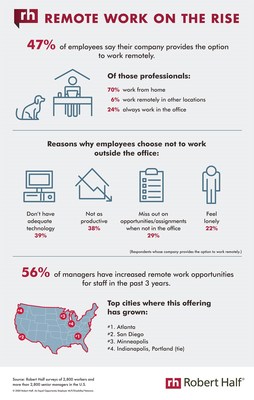Payroll
How Common are Remote Work Arrangements?
In a new survey from global staffing firm Robert Half, less than half of professionals (47%) said their company provides the option to work off-site. Of those, 70% take advantage of the perk and work from home...
Jan. 22, 2020

How common are remote work arrangements? In a new survey from global staffing firm Robert Half, less than half of professionals (47%) said their company provides the option to work off-site. Of those, 70% take advantage of the perk and work from home; an additional 6% do their job from another location, such as a café or shared office space.
For the remaining 24%, not having the right technology (39%) and being less productive due to distractions (38%) are the main deterrents to working outside the office.

View larger infographic.
Companies today are taking steps to support staff who want more flexibility. In a separate Robert Half survey of senior managers, more than half of respondents (56%) said their organization has expanded remote work opportunities for employees in the past three years.
“In an employment market that favors job seekers, businesses need to provide greater workplace flexibility to attract and retain top performers,” said Paul McDonald, senior executive director of Robert Half. “This goes beyond giving staff permission to work off-site or during nontraditional hours. Employers should check that professionals have the proper equipment and guidelines to do their jobs effectively outside the office.”
McDonald added, “It’s important for employees to realize that telecommuting isn’t the right solution for every person or every job. Individuals who are offered this perk can set themselves up for success by creating an optimal workspace and keeping in frequent touch with members of their team.”
Additional findings:
- Among the 28 U.S. cities in the survey, San Diego, Austin and Chicago have the most companies that provide remote arrangements.
- Employees in Chicago, Phoenix and San Diego are most likely to work from home when given the opportunity.
- More men (77%) than women (64%) work from home. About three-quarters of working parents (74%) take advantage of this perk versus 64% of those without children.
- Atlanta, San Diego and Minneapolis have the most senior managers who said they’ve increased remote work opportunities for employees in the past three years.
For more tips on offering remote work arrangements, visit the Robert Half blog.
